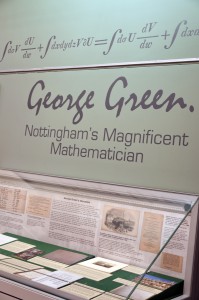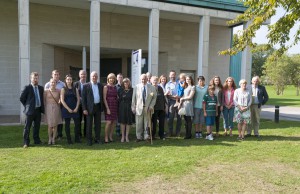September 17, 2014, by Kathryn Summerwill
George Green: Nottingham’s Magnificent Mathematician
Our new exhibition at the Weston Gallery focuses on a “local hero” – the miller from Sneinton whose pioneering mathematical work now underpins scientific research in areas as diverse as quantum physics, optics, radar, structural engineering and biomechanics. Sadly, George Green (1793-1841) died before his real genius was understood.
As the curator, I wanted to explore a number of different themes concerning George Green. Firstly, there was his biographical record: who was he, and what relics do we now have of his life? This theme was problematic, because so little direct evidence survives. There are no known portraits or photos, and his personal papers were apparently destroyed in the early 20th century. The George Green collection contains copies of all the known written evidence about Green and his family, and the 19th-century Nottingham in which they lived – and many of these items are on display, giving a local context to George Green’s life, schooling, and the mill in which he toiled.
The second theme was his academic work. A copy of his seminal An Essay on the Application of Mathematical Analysis to the Theories of Electricity and Magnetism, published in 1828, is on display alongside details of his other papers, some of which are also very significant to current science. Two mathematical techniques invented by Green in 1828 to aid his calculations are now known as Green’s Theorem and Green’s Functions. These are rather incomprehensible to non-scientists – they are taught at second-year undergraduate and postgraduate level – but I have attempted to explain what kind of science uses Green’s work, and why it is still important. In this I was greatly helped by members of the Schools of Mathematics and Physics. I was excited to discover that a Green’s Function had been used in the mathematical calculations which lay behind the development of Magnetic Resonance Imaging (MRI) technology by Sir Peter Mansfield and the team of physicists at The University of Nottingham. Professor Roger Bowley will be explaining all about this in a lunchtime talk on 21 November (details below).
Finally, there was the theme of remembering and commemorating Green. It struck me that all of Green’s major biographers had connections with Nottingham. His most recent, the late Mary Cannell, was for many years Secretary of the George Green Memorial Fund (GGMF). The exhibition contains many items, including an appeal leaflet, newspaper articles and photographs, concerning their work in raising the money to restore Green’s Mill in Sneinton during the 1970s and 1980s. The GGMF was also involved in major celebrations in 1993 to commemorate the bicentenary of Green’s birth, culminating in the dedication of a memorial plaque to Green in Westminster Abbey. The fact that the cutting-edge MRI technology was also developed in Nottingham seems very fitting, and I am very pleased that the exhibition can provide another way of celebrating George Green and his achievements in his hometown.
A group of George Green’s descendants attended the 1993 bicentenary events, and I was delighted that many of them also came along to the opening of this exhibition with their children and grandchildren. They are rightly proud of their illustrious ancestor. The following day the group visited Green’s Mill to see where he worked – although by all accounts he preferred his mathematical studies to the hard physical labour at the mill!
The exhibition runs in the Weston Gallery, Nottingham Lakeside Arts until 4th January 2015.
A series of talks will be held to accompany the exhibition. Places are limited so please book in advance with the Box Office on 0115 846 7777
Wednesday 1 October, 1pm-2pm: George Green and His Mill
Green’s Mill in Sneinton dates back to 1807. After a prominent fundraising campaign in the 1970s and 1980s it was restored and re-opened as a science centre in 1985. The following year flour was ground there again for the first time since the 1860s. In this talk, Tom Huggon, Chairman of the Friends of Green’s Mill, discusses George Green’s work as a miller, the mill’s history and its future.
Tuesday 21 October, 1pm-2pm: George Green’s Contribution to MRI
George Green introduced two mathematical concepts: the idea of a potential energy in physical problems, and a way of calculating it for complex systems using what is now called Green’s function. Both of these ideas, suitably extended, proved central to the Nottingham design of actively screened coils for Magnetic Resonance Imaging. Emeritus Professor Roger Bowley of the School of Physics explains how the team used Green’s techniques in their work.
Wednesday 12 November, 1pm-2pm: George Green’s Mathematical Influences
George Green was “an almost entirely self-taught mathematical genius” (NM Ferrers 1871) whose work was a major influence on the mathematical physics of the 19th and 20th centuries and shows no signs of stopping in the 21st. But from where or from whom did Green learn his mathematics? Peter Rowlett from Nottingham Trent University surveys Green’s education in Nottingham and Cambridge and those who influenced him.
No comments yet, fill out a comment to be the first




Leave a Reply